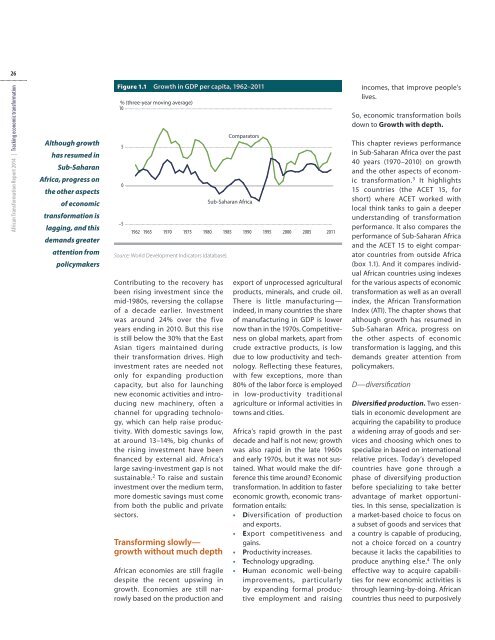2014-african-transformation-report
2014-african-transformation-report
2014-african-transformation-report
Create successful ePaper yourself
Turn your PDF publications into a flip-book with our unique Google optimized e-Paper software.
26African Transformation Report <strong>2014</strong> | Tracking economic <strong>transformation</strong>Although growthhas resumed inSub- SaharanAfrica, progress onthe other aspectsof economic<strong>transformation</strong> islagging, and thisdemands greaterattention frompolicymakersFigure 1.1 Growth in GDP per capita, 1962–2011% (three-year moving average)1050–51962 1965197019751980Source: World Development Indicators (database).Contributing to the recovery hasbeen rising investment since themid-1980s, reversing the collapseof a decade earlier. Investmentwas around 24% over the fiveyears ending in 2010. But this riseis still below the 30% that the EastAsian tigers maintained duringtheir <strong>transformation</strong> drives. Highinvestment rates are needed notonly for expanding productioncapacity, but also for launchingnew economic activities and introducingnew machinery, often achannel for upgrading technology,which can help raise productivity.With domestic savings low,at around 13–14%, big chunks ofthe rising investment have beenfinanced by external aid. Africa’slarge saving- investment gap is notsustainable. 2 To raise and sustaininvestment over the medium term,more domestic savings must comefrom both the public and privatesectors.Transforming slowly—growth without much depthAfrican economies are still fragiledespite the recent upswing ingrowth. Economies are still narrowlybased on the production and1985ComparatorsSub-Saharan Africa19901995200020052011export of unprocessed agriculturalproducts, minerals, and crude oil.There is little manufacturing—indeed, in many countries the shareof manufacturing in GDP is lowernow than in the 1970s. Competitivenesson global markets, apart fromcrude extractive products, is lowdue to low productivity and technology.Reflecting these features,with few exceptions, more than80% of the labor force is employedin low-productivity traditionalagriculture or informal activities intowns and cities.Africa’s rapid growth in the pastdecade and half is not new; growthwas also rapid in the late 1960sand early 1970s, but it was not sustained.What would make the differencethis time around? Economic<strong>transformation</strong>. In addition to fastereconomic growth, economic <strong>transformation</strong>entails:• Diversification of productionand exports.• Export competitiveness andgains.• Productivity increases.• Technology upgrading.• Human economic well-beingimprovements, particularlyby expanding formal productiveemployment and raisingincomes, that improve people’slives.So, economic <strong>transformation</strong> boilsdown to Growth with depth.This chapter reviews performancein Sub- Saharan Africa over the past40 years (1970–2010) on growthand the other aspects of economic<strong>transformation</strong>. 3 It highlights15 countries (the ACET 15, forshort) where ACET worked withlocal think tanks to gain a deeperunderstanding of <strong>transformation</strong>performance. It also compares theperformance of Sub- Saharan Africaand the ACET 15 to eight comparatorcountries from outside Africa(box 1.1). And it compares individualAfrican countries using indexesfor the various aspects of economic<strong>transformation</strong> as well as an overallindex, the African TransformationIndex (ATI). The chapter shows thatalthough growth has resumed inSub- Saharan Africa, progress onthe other aspects of economic<strong>transformation</strong> is lagging, and thisdemands greater attention frompolicymakers.D—diversificationDiversified production. Two essentialsin economic development areacquiring the capability to producea widening array of goods and servicesand choosing which ones tospecialize in based on internationalrelative prices. Today’s developedcountries have gone through aphase of diversifying productionbefore specializing to take betteradvantage of market opportunities.In this sense, specialization isa market-based choice to focus ona subset of goods and services thata country is capable of producing,not a choice forced on a countrybecause it lacks the capabilities toproduce anything else. 4 The onlyeffective way to acquire capabilitiesfor new economic activities isthrough learning-by-doing. Africancountries thus need to purposively


